fuel TOYOTA TUNDRA 2020 Owners Manual (in English)
[x] Cancel search | Manufacturer: TOYOTA, Model Year: 2020, Model line: TUNDRA, Model: TOYOTA TUNDRA 2020Pages: 52, PDF Size: 3.85 MB
Page 3 of 52

1
OVERVIEW
FEATURES & OPERATIONS
TOYOTA SAFETY SENSE
SAFETY & EMERGENCY FEATURES
INDEX
Engine maintenance 8
Fuel tank door release & cap 7
Hood release 8
Indicator symbols 4-5
Instrument cluster 4
Instrument panel 2-3
Instrument panel light control 8
Keyless entry1 6
Smart Key system1,2 7
OVERVIEW
FEATURES & OPERATIONS
FEATURES & OPERATIONS (continued)
SAFETY & EMERGENCY FEATURES
Air conditioning/heating 18
Audio 20
Auto lock/unlock1 9
Automatic transmission 10
Bottle holders 28
Blind Spot Monitor with Rear
Cross Traffic Alert (BSM w/RCTA) 26
Cup holders 29
Door locks 11
Garage door opener (HomeLink®)3 28
Headlight leveling dial 13
Intuitive parking assist 27
Lights1 & turn signals 12
Mirrors-Power outside rear view 9
Moonroof 14
Multi-Information Display (MID)2 21
Parking brake 14
Power outlets-12V DC 22
Rear view monitor system 19
Seat adjustments-Front 16-17
Seat folding-Rear 17
Seat heaters/ventilators 19
Seats-Head restraints 17
Steering lock release 14
Steering wheel switches &
telephone controls (Bluetooth®) 23
Tilt & telescopic steering wheel 11
TOW/HAUL switch 25
Trailer brake controller 24
Two & four-wheel drive selector 24
USB charge-ports 20
USB media port 21
Vehicle Stability Control (VSC)
OFF switch 26
Window-Power back 15
Windows-Power 15
Windshield wipers & washers 13
Floor mat installation 45
Rear door child safety locks 42
Safety Connect 42
Seat belts 41
Seat belts-Shoulder belt anchor 41
Spare tire & tools 43
Star Safety System 44-45
Trailer Sway Control 45
Tire Pressure Monitoring
(warning) System (TPMS) 41
BLUETOOTH® DEVICE PAIRING SECTION 46-48
1 Visit your Toyota dealer for information on customizing this feature.2 Programmable by customer. Refer to the Owner’s Manual for instructions and more information.3 HomeLink® is a registered trademark of Gentex Corporation.
TOYOTA SAFETY SENSE™ P (TSS-P)
Automatic High Beams (AHB) 40
Dynamic Radar
Cruise Control (DRCC) 37-39
Lane Departure Alert (LDA) 33-36
Pre-Collision System with
Pedestrian Detection (PCS w/PD) 31-33
Quick overview-
Toyota Safety Sense™ P (TSS-P) 30
Sensors 30
Page 6 of 52
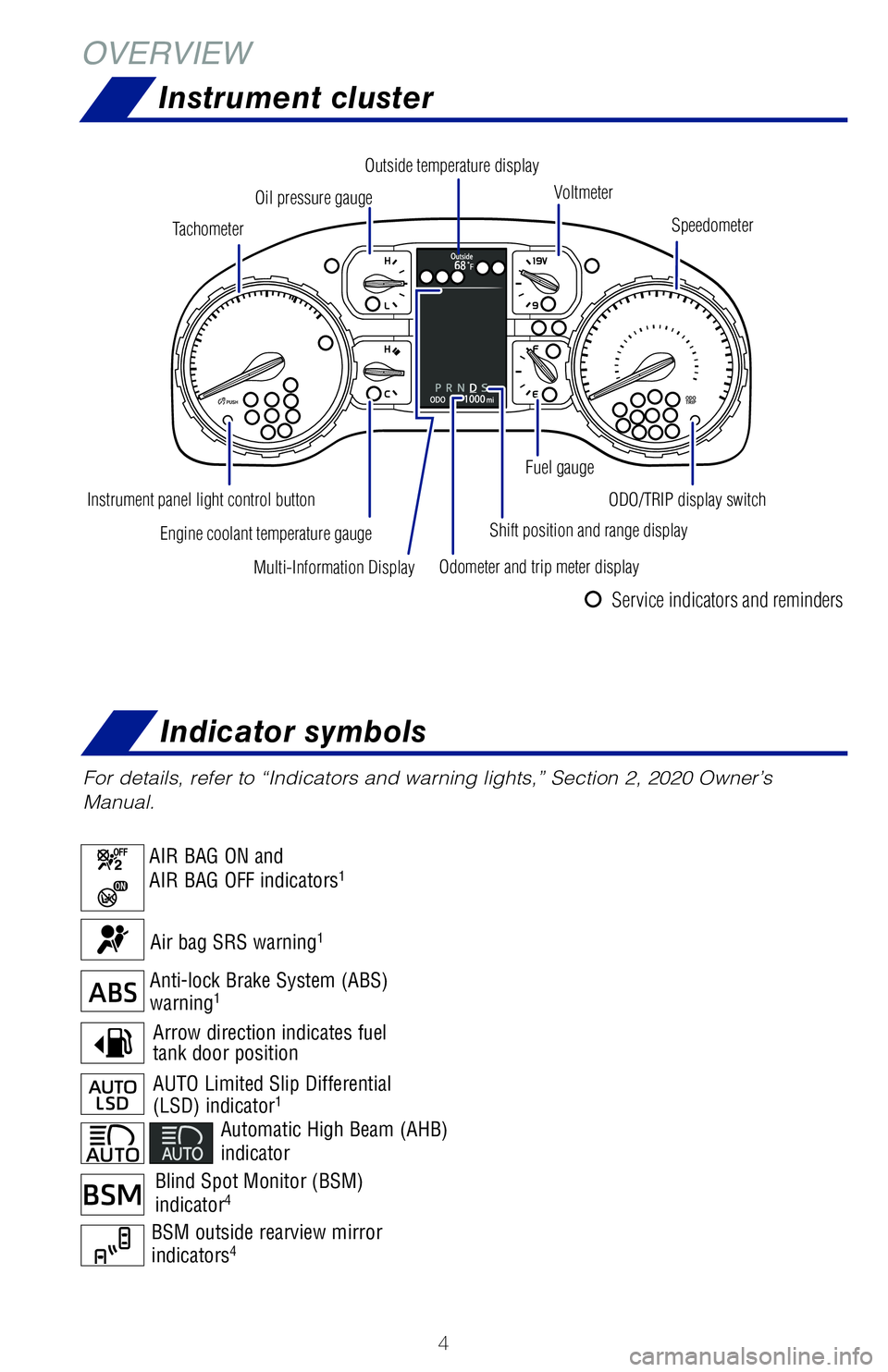
4
Instrument cluster
For details, refer to “Indicators and warning lights,” Section 2, 2020 Owner’s
Manual.
Multi-Information Display
Speedometer
Outside temperature display
Fuel gauge
ODO/TRIP display switch
Shift position and range display
Odometer and trip meter display
Instrument panel light control button
Oil pressure gauge
Engine coolant temperature gauge
Voltmeter
Tachometer
Air bag SRS warning1
AIR BAG ON and
AIR BAG OFF indicators1
BSM outside rearview mirror
indicators4
Indicator symbols
Automatic High Beam (AHB)
indicator
Blind Spot Monitor (BSM)
indicator4
Arrow direction indicates fuel tank door position
AUTO Limited Slip Differential (LSD) indicator1
Anti-lock Brake System (ABS) warning1
OVERVIEW
Service indicators and reminders
Page 7 of 52
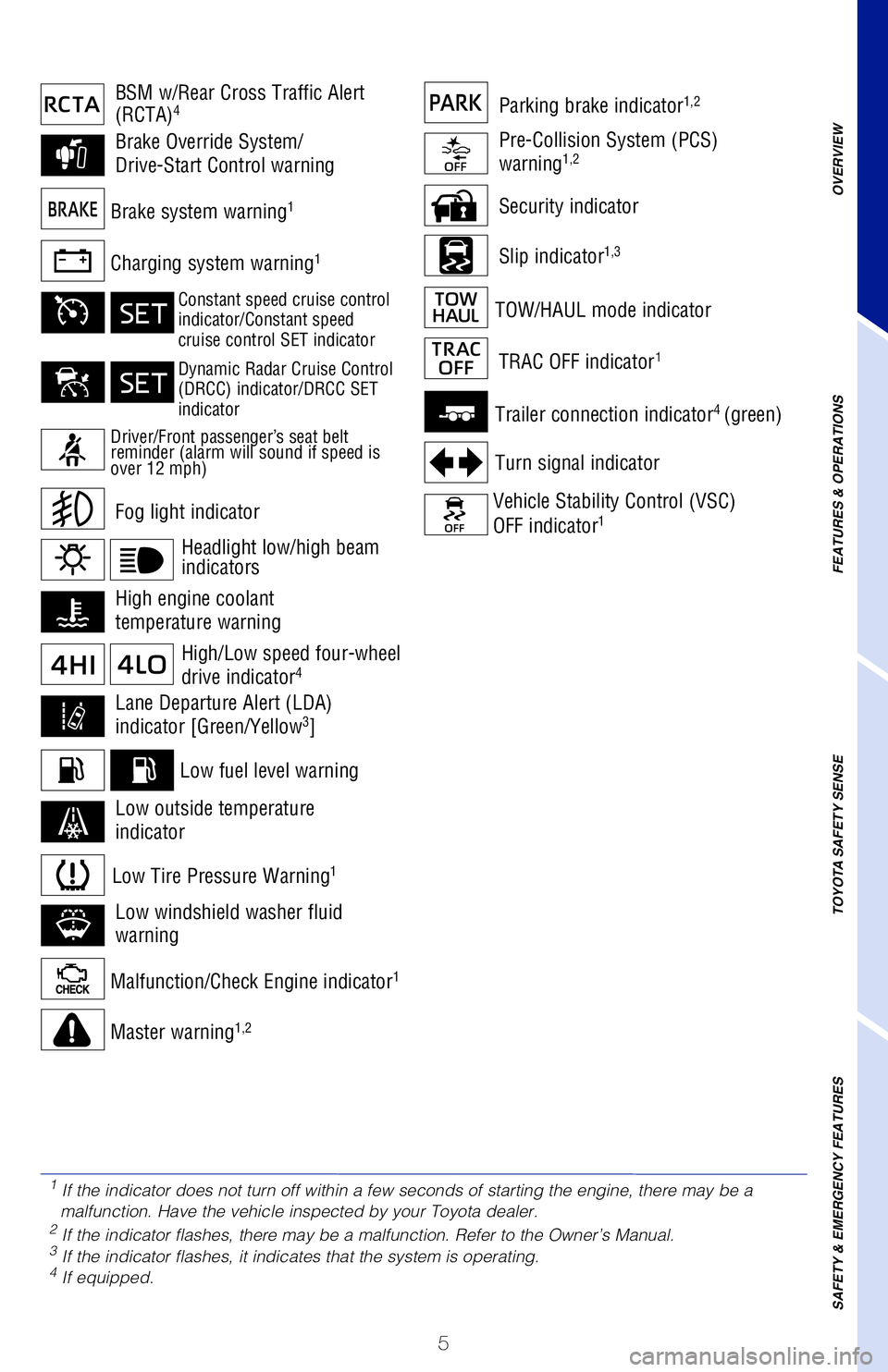
5
Security indicator
Slip indicator1,3Charging system warning1
Brake system warning1
Malfunction/Check Engine indicator1
Low fuel level warning
Master warning1,2
Trailer connection indicator4 (green)
Turn signal indicator
Vehicle Stability Control (VSC)
OFF indicator1
TOW/HAUL mode indicator
Low Tire Pressure Warning1
Fog light indicator
Brake Override System/
Drive-Start Control warning
BSM w/Rear Cross Traffic Alert (RCTA)4
High engine coolant
temperature warning
TRAC OFF indicator1
Lane Departure Alert (LDA)
indicator [Green/Yellow3]
Pre-Collision System (PCS)
warning1,2
Low windshield washer fluid
warning
Low outside temperature
indicator
Parking brake indicator1,2
High/Low speed four-wheel
drive indicator4
1 If the indicator does not turn off within a few seconds of starting the engine, there may be a malfunction. Have the vehicle inspected by your Toyota dealer.2 If the indicator flashes, there may be a malfunction. Refer to the Owner’s Manual.3 If the indicator flashes, it indicates that the system is operating.4 If equipped.
Driver/Front passenger’s seat belt reminder (alarm will sound if speed is over 12 mph)
Constant speed cruise control indicator/Constant speedcruise control SET indicator
Dynamic Radar Cruise Control (DRCC) indicator/DRCC SET indicator
Headlight low/high beam indicators
OVERVIEW
FEATURES & OPERATIONS
TOYOTA SAFETY SENSE
SAFETY & EMERGENCY FEATURES
Page 9 of 52
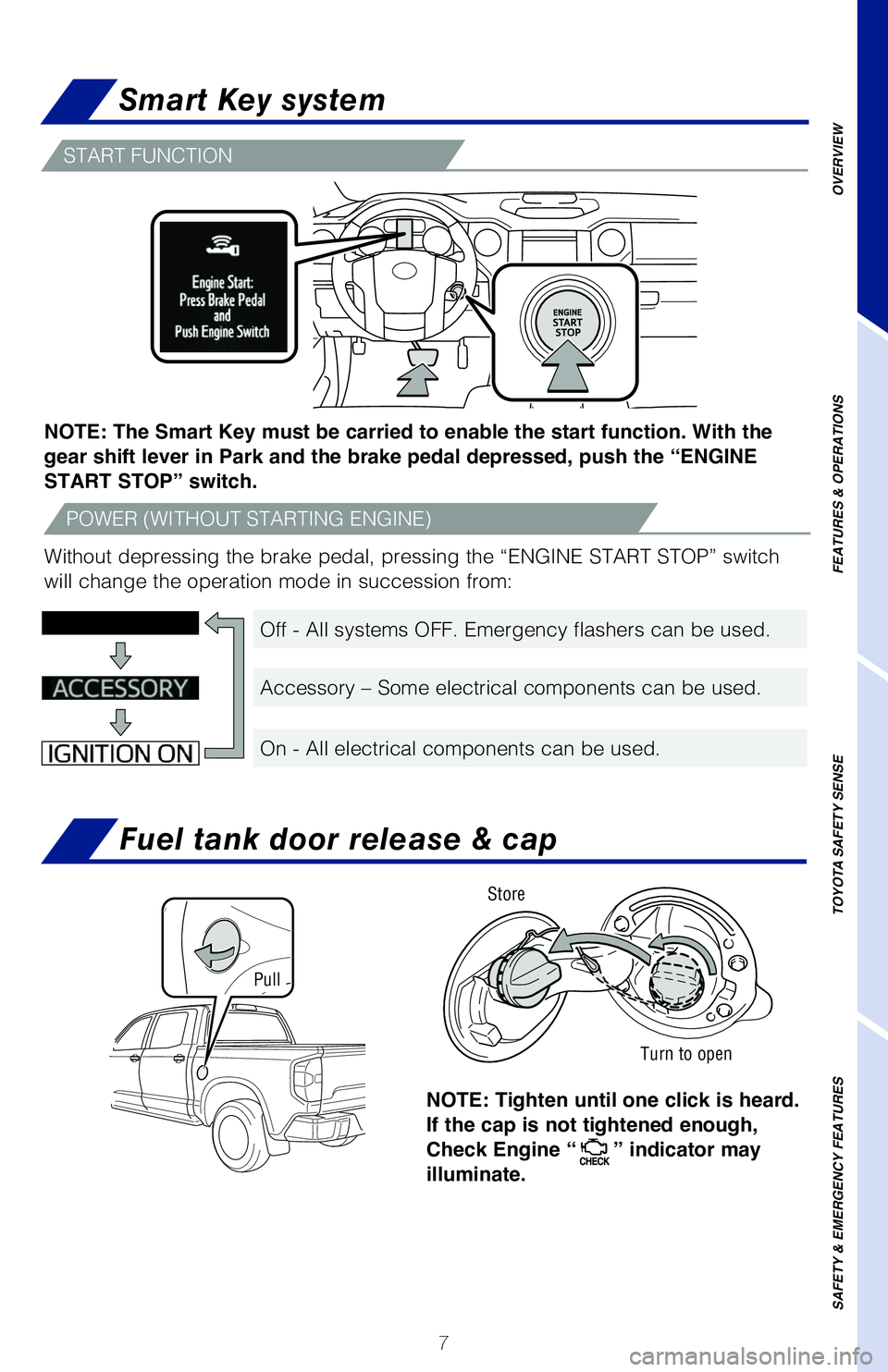
7
OVERVIEW
FEATURES & OPERATIONS
TOYOTA SAFETY SENSE
SAFETY & EMERGENCY FEATURES
Fuel tank door release & cap
NOTE: Tighten until one click is heard.
If the cap is not tightened enough,
Check Engine “” indicator may
illuminate.
Pull
Turn to open
Store
Smart Key system
NOTE: The Smart Key must be carried to enable the start function. With the
gear shift lever in Park and the brake pedal depressed, push the “ENGINE
START STOP” switch.
Without depressing the brake pedal, pressing the “ENGINE START STOP” switch
will change the operation mode in succession from:
Off - All systems OFF. Emergency flashers can be used.
Accessory – Some electrical components can be used.
On - All electrical components can be used.
START FUNCTION
POWER (WITHOUT STARTING ENGINE)
Page 12 of 52
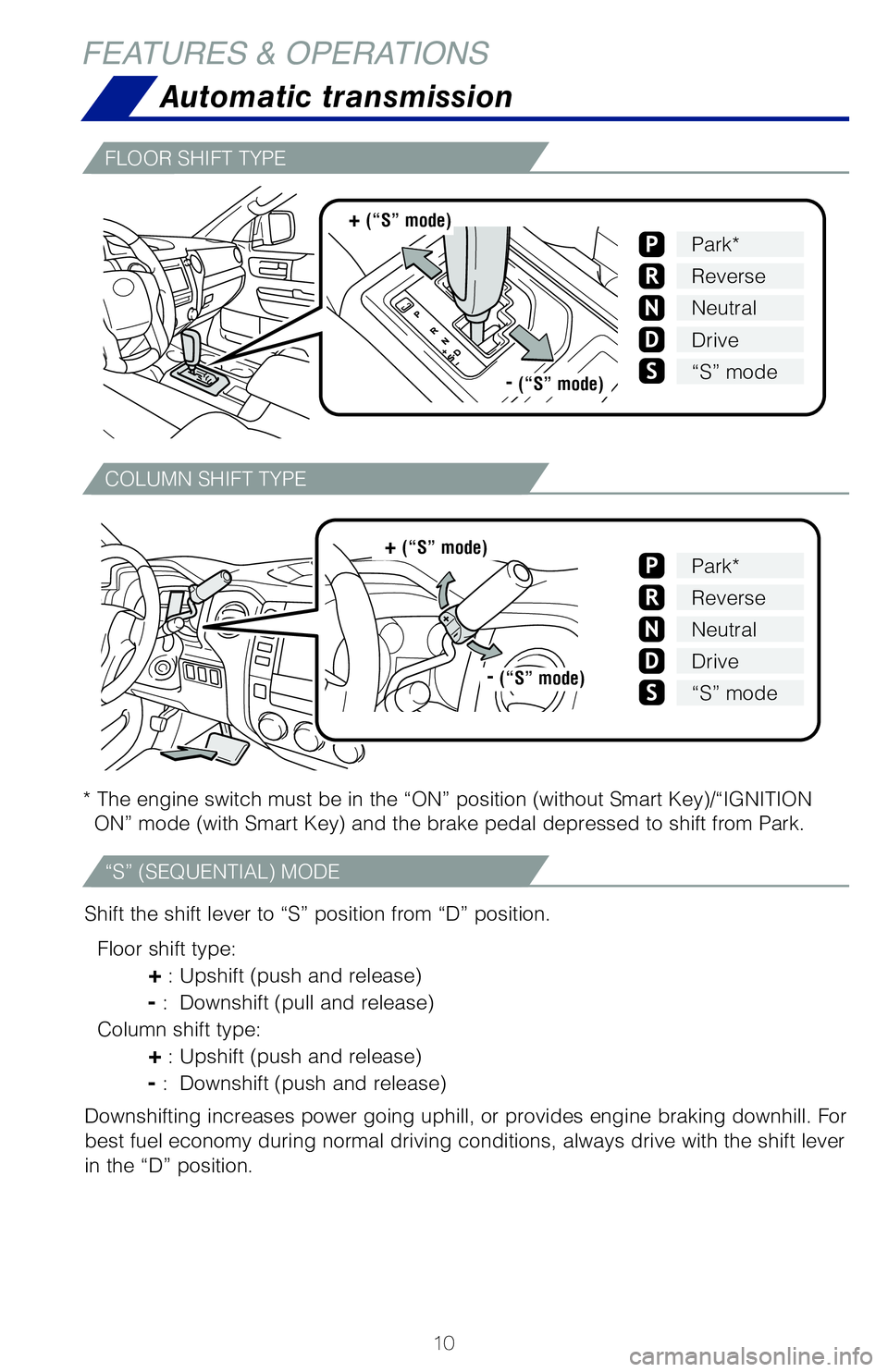
10
FEATURES & OPERATIONS
Shift the shift lever to “S” position from “D” position.
Floor shift type:
+ : Upshift (push and release)
- : Downshift (pull and release)
Column shift type:
+ : Upshift (push and release)
- : Downshift (push and release)
Downshifting increases power going uphill, or provides engine braking downhill. For
best fuel economy during normal driving conditions, always drive with the shift lever
in the “D” position.
* The engine switch must be in the “ON” position (without Smart Key)/“IGNITION
ON” mode (with Smart Key) and the brake pedal depressed to shift from Park.
Park*
Reverse
Neutral
Drive
N
“S” mode
Park*
Reverse
Neutral
Drive
“S” mode
N
+ (“S” mode)
- (“S” mode)
+ (“S” mode)
- (“S” mode)
FLOOR SHIFT TYPE
COLUMN SHIFT TYPE
“S” (SEQUENTIAL) MODE
Automatic transmission
Page 26 of 52

24
FEATURES & OPERATIONS
Push and turnTurn
Shifting between “2WD” and “4H”
Reduce speed to less than 62 mph, then turn control to “2WD” or “4H.”
Shifting between “4H” and “4L”
When stopped shift to “N” position, then push and turn to “4L” from “4H.”
NOTE: For best fuel economy and performance under normal driving
conditions, keep in “2WD” position.
2WDHigh speed (2WD) Normal driving on dry hard-surfaced roads.
4HHigh speed (4WD) For driving only on roads that permit the tires to
slide, like off-road, icy or snow-covered roads.
4L
Low speed (4WD)
For maximum power and traction when climbing or descending steep
hills, off-road driving, and hard pulling in sand, mud or deep snow.
Turn
Two & four-wheel drive selector (if equipped)
The trailer brakes can be controlled by the Trailer brake controller via the 7-pin
connector. By selecting the type of brakes that are being used on the trailer
(electric or electric-over-hydraulic) and setting the gain for the controller, the
manual TRAILER BRAKE OUTPUT slider is used to slow just the trailer. The vehicle
brake pedal will also slow down as well as stop the trailer when applied. Gain
values, manual brake outputs, trailer brake types and the trailer connection status
are displayed in the multi-information display.
Refer to the Owner’s Manual for more details.
Trailer brake controller (if equipped)
Trailer connector indicator
Trailer brake typeGAIN (+/-) selection button
Manual TRAILER
BRAKE OUTPUT slider
Page 27 of 52
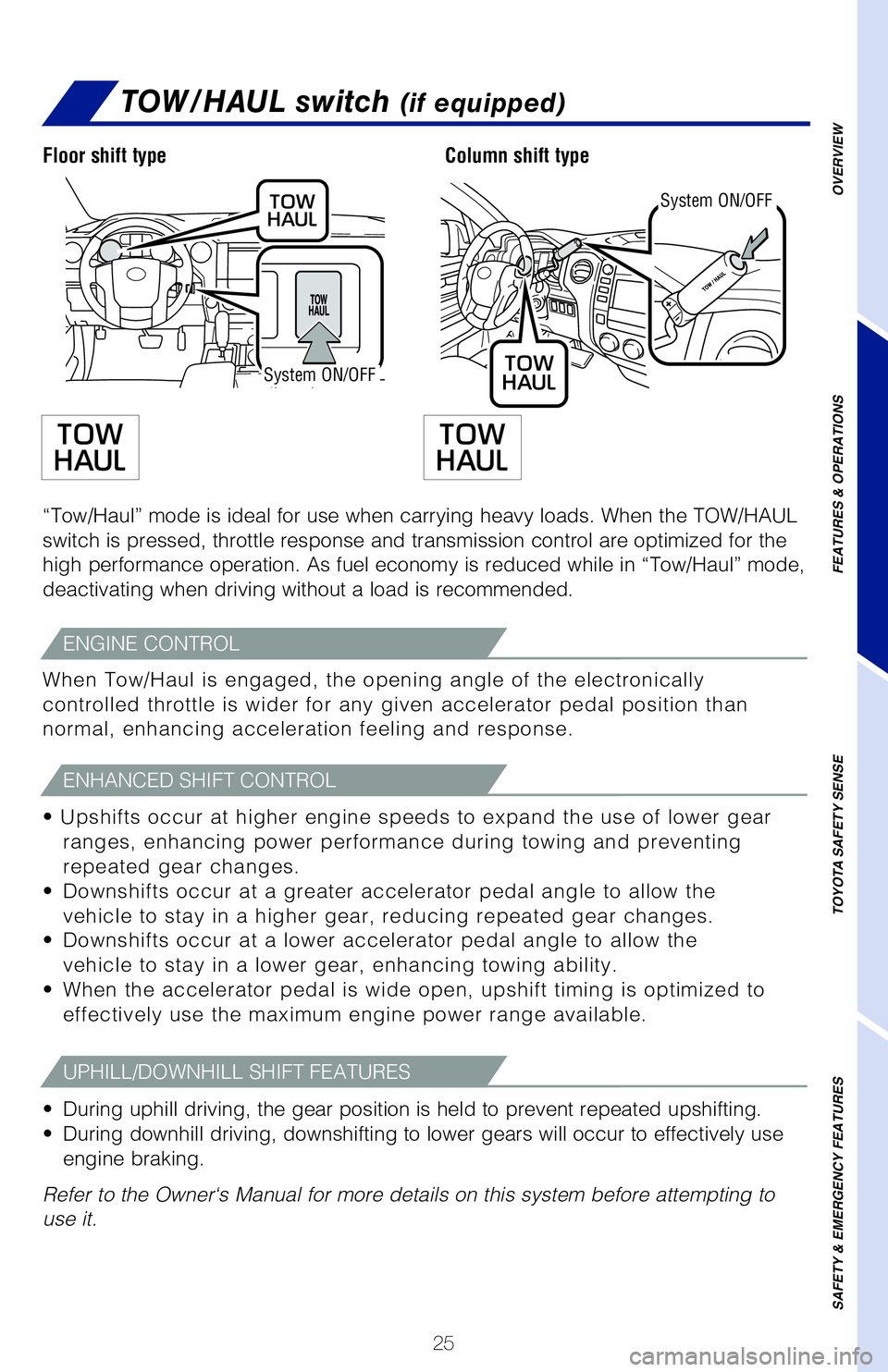
25
TOW/HAUL switch (if equipped)
“Tow/Haul” mode is ideal for use when carrying heavy loads. When the TOW/HAUL
switch is pressed, throttle response and transmission control are optimized for the
high performance operation. As fuel economy is reduced while in “Tow/Haul” mode,
deactivating when driving without a load is recommended.
• Upshifts occur at higher engine speeds to expand the use of lower gear
ranges, enhancing power performance during towing and preventing
repeated gear changes.
• Downshifts occur at a greater accelerator pedal angle to allow the
vehicle to stay in a higher gear, reducing repeated gear changes.
• Downshifts occur at a lower accelerator pedal angle to allow the
vehicle to stay in a lower gear, enhancing towing ability.
• When the accelerator pedal is wide open, upshift timing is optimized to
effectively use the maximum engine power range available.
When Tow/Haul is engaged, the opening angle of the electronically
controlled throttle is wider for any given accelerator pedal position than
normal, enhancing acceleration feeling and response.
• During uphill driving, the gear position is held to prevent repeated upshifting.
• During downhill driving, downshifting to lower gears will occur to effectively use
engine braking.
Refer to the Owner‘s Manual for more details on this system before attempting to
use it.
Floor shift type
System ON/OFF
System ON/OFF
Column shift type
ENGINE CONTROL
ENHANCED SHIFT CONTROL
UPHILL/DOWNHILL SHIFT FEATURES
OVERVIEW
FEATURES & OPERATIONS
TOYOTA SAFETY SENSE
SAFETY & EMERGENCY FEATURES